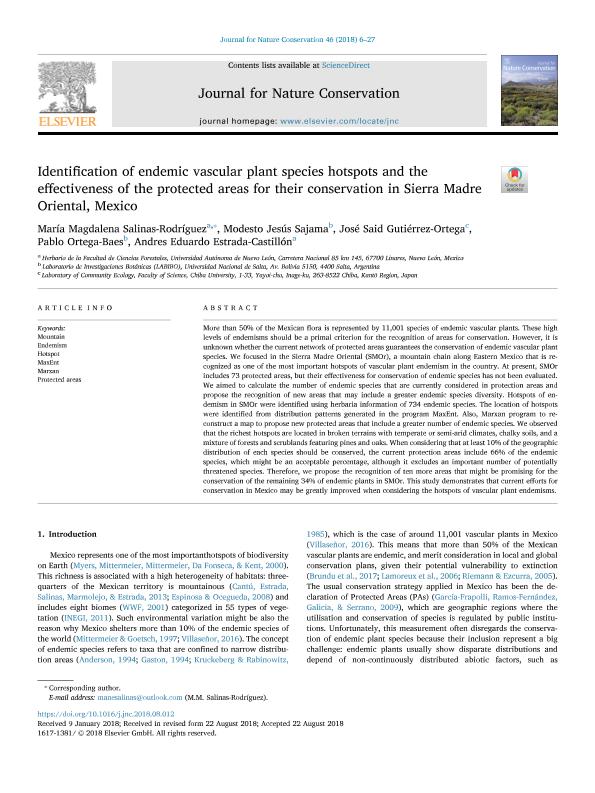Mostrar el registro sencillo del ítem
dc.contributor.author
Salinas Rodríguez, María Magdalena
dc.contributor.author
Sajama, Modesto Jesus

dc.contributor.author
Gutiérrez-Ortega, José Said
dc.contributor.author
Ortega Baes, Francisco Pablo

dc.contributor.author
Estrada Castillón, Andres Eduardo
dc.date.available
2019-12-30T15:15:56Z
dc.date.issued
2018-12
dc.identifier.citation
Salinas Rodríguez, María Magdalena; Sajama, Modesto Jesus; Gutiérrez-Ortega, José Said; Ortega Baes, Francisco Pablo; Estrada Castillón, Andres Eduardo; Identification of endemic vascular plant species hotspots and the effectiveness of the protected areas for their conservation in Sierra Madre Oriental, Mexico; Elsevier Gmbh; Journal For Nature Conservation; 46; 12-2018; 6-27
dc.identifier.issn
1617-1381
dc.identifier.uri
http://hdl.handle.net/11336/93213
dc.description.abstract
More than 50% of the Mexican flora is represented by 11,001 species of endemic vascular plants. These high levels of endemisms should be a primal criterion for the recognition of areas for conservation. However, it is unknown whether the current network of protected areas guarantees the conservation of endemic vascular plant species. We focused in the Sierra Madre Oriental (SMOr), a mountain chain along Eastern Mexico that is recognized as one of the most important hotspots of vascular plant endemism in the country. At present, SMOr includes 73 protected areas, but their effectiveness for conservation of endemic species has not been evaluated. We aimed to calculate the number of endemic species that are currently considered in protection areas and propose the recognition of new areas that may include a greater endemic species diversity. Hotspots of endemism in SMOr were identified using herbaria information of 734 endemic species. The location of hotspots were identified from distribution patterns generated in the program MaxEnt. Also, Marxan program to reconstruct a map to propose new protected areas that include a greater number of endemic species. We observed that the richest hotspots are located in broken terrains with temperate or semi-arid climates, chalky soils, and a mixture of forests and scrublands featuring pines and oaks. When considering that at least 10% of the geographic distribution of each species should be conserved, the current protection areas include 66% of the endemic species, which might be an acceptable percentage, although it excludes an important number of potentially threatened species. Therefore, we propose the recognition of ten more areas that might be promising for the conservation of the remaining 34% of endemic plants in SMOr. This study demonstrates that current efforts for conservation in Mexico may be greatly improved when considering the hotspots of vascular plant endemisms.
dc.format
application/pdf
dc.language.iso
eng
dc.publisher
Elsevier Gmbh

dc.rights
info:eu-repo/semantics/openAccess
dc.rights.uri
https://creativecommons.org/licenses/by-nc-nd/2.5/ar/
dc.subject
ENDEMISM
dc.subject
HOTSPOT
dc.subject
MARXAN
dc.subject
MAXENT
dc.subject
MOUNTAIN
dc.subject
PROTECTED AREAS
dc.subject.classification
Ecología

dc.subject.classification
Ciencias Biológicas

dc.subject.classification
CIENCIAS NATURALES Y EXACTAS

dc.title
Identification of endemic vascular plant species hotspots and the effectiveness of the protected areas for their conservation in Sierra Madre Oriental, Mexico
dc.type
info:eu-repo/semantics/article
dc.type
info:ar-repo/semantics/artículo
dc.type
info:eu-repo/semantics/publishedVersion
dc.date.updated
2019-10-23T21:32:15Z
dc.journal.volume
46
dc.journal.pagination
6-27
dc.journal.pais
Alemania

dc.description.fil
Fil: Salinas Rodríguez, María Magdalena. Universidad Autónoma de Nuevo León; México
dc.description.fil
Fil: Sajama, Modesto Jesus. Universidad Nacional de Salta. Facultad de Ciencias Naturales. Escuela de Agronomía. Laboratorio de Investigaciones Botánicas; Argentina. Consejo Nacional de Investigaciones Científicas y Técnicas; Argentina
dc.description.fil
Fil: Gutiérrez-Ortega, José Said. Chiba University; Japón
dc.description.fil
Fil: Ortega Baes, Francisco Pablo. Consejo Nacional de Investigaciones Científicas y Técnicas; Argentina. Universidad Nacional de Salta. Facultad de Ciencias Naturales. Escuela de Agronomía. Laboratorio de Investigaciones Botánicas; Argentina
dc.description.fil
Fil: Estrada Castillón, Andres Eduardo. Universidad Autónoma de Nuevo León; México
dc.journal.title
Journal For Nature Conservation

dc.relation.alternativeid
info:eu-repo/semantics/altIdentifier/doi/http://dx.doi.org/10.1016/j.jnc.2018.08.012
dc.relation.alternativeid
info:eu-repo/semantics/altIdentifier/url/https://www.sciencedirect.com/science/article/pii/S1617138118300086
Archivos asociados
